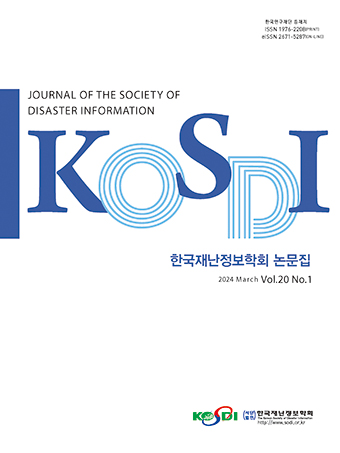Original Article
Abstract
References
Information
Purpose: This study aims to quantitatively determine the impact on nearby risidents by selecting the amount of chemicals emitted from the workplace among the substances subject to the chemical emission plan and predicting the concentration with the atmospheric diffusion program. Method: The selection of research materials considered half-life, toxicity, and the presence or absence of available monitoring station data. The areas discharged from the materials to be studied were selected as the areas to be studied, and four areas with floating populations were selected to evaluate health risks. Result: AERMOD was executed after conducting terrain and meteorological processing to obtain predicted concentrations. The health hazard assessment results indicated that only dichloromethane exceeded the threshold for children, while tetrachloroethylene and chloroform appeared at levels that cannot be ignored for both children and adults. Conclusion: Currently, in the domestic context, health hazard assessments are conducted based on the regulations outlined in the “Environmental Health Act” where if the hazard index exceeds a certain threshold, it is considered to pose a health risk. The anticipated expansion of the list of substances subject to the chemical discharge plan to 415 types by 2030 suggests the need for efficient management within workplaces. In instances where the hazard index surpasses the threshold in health hazard assessments, it is judged that effective chemical management can be achieved by prioritizing based on considerations of background concentration and predicted concentration through atmospheric dispersion modeling.
연구목적: 사업장 주변에 배출되는 화학물질의 양을 선정하여 대기확산 프로그램으로 농도를 예측하여 인근 주민들에게 영향을 정량적으로 파악하는 것을 목적으로 하였다. 연구방법: 연구물질의 선정은 반감기, 독성, 이용 가능한 측정소 자료의 유무를 고려하였다. 또한 연구대상물질에서 배출되는 지역을 연구대상 지역으로 선정하였으며, 유동인구가 있는 4개 지역을 선정하여 건강위해성을 평가하였다. 연구결과: AERMOD를 구동하기 위하여 지형 및 기상 처리를 실시 후 예측 농도를 구하였다. 위해성 평가 결과 어린이에서만 디클로로메탄이 초과되는 것으로 나타났으나, 테트라클로로에틸렌과 클로로포름은 어린이와 성인 모두 무시할 수 없는 수준으로 나타났다. 결론: 현재 국내 건강위해성평가는 “환경보건법”의 규정에 따라 위해지수가 일정 기준을 초과할 경우 위해성이 있는 것으로 간주된다. 향후 화학물질배출계획서 대상물질이 2030년에는 415종으로 확대되어 사업장에서 효율적인 관리가 필요함을 시사한다. 위해성 평가에서 위해성지수를 초과하는 경우 대기확산 모델링을 통해 배경농도와 예측농도를 고려하여 우선순위를 부여함으로써 화학물질 관리를 효과적으로 수행할 수 있을 것으로 판단된다.
- Do, S.-H. (2010). Air Quality and Health Risk Assessment for the City of Daegu Using CALPUFF Diffusion Model. Ph.D. Dissertation, Kyemyoung University.
- Kim, S.-H, Park, S.-H., Joo, H.-S., So, M.-S., Lee, N.-H. (2023). "A study on improvement of air quality dispersion model application method in environmental impact assessment(II) -Focusing on AERMOD model application method-." Journal of Environmental Impact Assessment, Vol. 32, No. 4, pp. 203-213.
- Kim, S.-H, Park, S.-H., Tak, J.-S., Ha, J.-S., Joo, H.-S., Lee, N.-H. (2022). "A study on improvement of air quality dispersion model application method in environmental impact assessment(I) -Focusing on AERMOD model application method-." Journal of Environmental Impact Assessment, Vol.31, No. 5, pp. 271-285.
- Lim, I.-H., Bae, S.-H. (2015). "A study on development of the meteorological data preprocessing program for air pollution modeling." The Journal of the Korea Institute of Electronic Communication Sciences, Vol. 10, No. 1, pp. 47-53. 10.13067/JKIECS.2015.10.1.47
- Ministry of Environment (MOE) (2013). Manual for Assessment of Health Impact Items. Sejong, Republic of Korea.
- Ministry of Environment (MOE) (2022a). Together with Public and Private, a Plan to Reform the Toxic Substance Designation and Management System is Prepared. Sejong, Republic of Korea.
- Ministry of Environment (MOE) (2022b). 2021 Chemical Release Inventory Survey. Sejong, Republic of Korea.
- Ministry of Environment (MOE) (2022c). Appended Table 2 of the Regulations on the Investigation of Chemical Substances and the Calculation of Emissions. Sejong, Republic of Korea.
- Ministry of Environment (MOE) (2023). Domestic Implementation Background. Pollutant Release and Transfer Register. http://icis.me.go.kr/prtr/dscamtExaminSystem/dmstcPrtnCrcmstncs.do.
- National Institute of Chemical Safety (NICS) (2020). 2020 Chemical Substance Emission Reduction Workplace Training (1. Overview of Chemical Substance Emission Reduction System) [video]. Youtube. https://www.youtube.com/watch?v=5Qv8quZ6h4l
- National Institute of Environmental Research (NIER) (2019a). Korean Children's Exposure Factor Handbook. Incheon, Republic of Korea.
- National Institute of Environmental Research (NIER) (2019b). "Korean Exposure Factor Handbook. Incheon, Republic of Korea.
- National Institute of Environmental Research (NIER) (2021). Atmospheric Environmental Yearbook 2020. Publication registaration number 11-1480523-0011980-10, Incheon, Republic of Korea.
- Song, Y., Moon, N., Sun, H., Lee, S. (2007). Study on Practical Guideline of Prediction Models in EIA. Environment Institute, Seoul, Korea.
- Publisher :The Korean Society of Disaster Information
- Publisher(Ko) :한국재난정보학회
- Journal Title :Journal of the Society of Disaster Information
- Journal Title(Ko) :한국재난정보학회논문집
- Volume : 20
- No :1
- Pages :93-105
- DOI :https://doi.org/10.15683/kosdi.2024.3.31.093




 Journal of the Society of Disaster Information
Journal of the Society of Disaster Information







